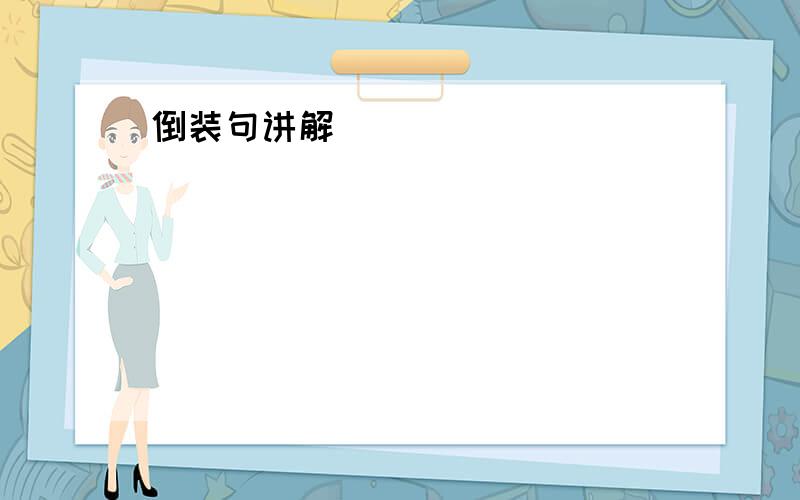倒装句讲解
来源:学生作业帮助网 编辑:作业帮 时间:2024/04/27 17:56:00

倒装句讲解
倒装句讲解
倒装句讲解
http://zhidao.baidu.com/question/325496235.html?an=0&si=2
在英语中,我们把主语在前谓语动词在后的句子叫陈述句,把谓语动词放在主语前面的句子叫倒装句。如果全部谓语放在主语之前,叫完全倒装;如果只把助动词或情态动词放在主语之前就叫部分倒装。
I. 完全倒装
1. 用于 there be 句型。
例如: There are some students in the classroom.
教室里有几...
全部展开
在英语中,我们把主语在前谓语动词在后的句子叫陈述句,把谓语动词放在主语前面的句子叫倒装句。如果全部谓语放在主语之前,叫完全倒装;如果只把助动词或情态动词放在主语之前就叫部分倒装。
I. 完全倒装
1. 用于 there be 句型。
例如: There are some students in the classroom.
教室里有几位学生。
There is a tall tree in front of the classroom.
教室的前面有一棵大树。
2. 用于“ here ( there, now, then )+不及物动词+主语”的句型中,或以 in, out, up, down, away 等副词开头的句子里,以表示强调。
例如: Here comes the bus. 汽车来了。
There goes the bell. 铃响了。
Now comes your turn. 现在轮到你了。
Out went the children. 孩子们出去了。
注意:
( 1 )主语是代词时,主语和谓语不倒装。
( 2 ) here , there 放在句首通常用一般现在时。
Here it is. 给你。(你要的东西在这儿。)
Here he comes. 他来了。
3. 当句首状语为表示地点的介词词组时,也常将其全部倒装。
例如: South of the city lies a big steel factory.
城市南边有一家大型钢厂。
From the valley came a frightening sound.
从山谷里传来了可怕的声音。
4. 表语置于句首时,倒装结构为“表语+连系动词+主语”:
( 1 )形容词+连系动词+主语
Present at the meeting were Mr Li, Mr Wang and many other teachers.
出席会议的有李老师、王老师和其他很多老师。
( 2 )过去分词+连系动词+主语
Gone are the days when we used foreign oil.
我们使用洋油的日子一去不复返了。
( 3 )介词短语+ be +主语
Among the goods are books, exercise-books, pens and some other things.
在所有的货物中有书、练习册、钢笔和其他东西。
5. 用于 so, neither , nor 开头的句子,表示重复前句的部分内容。原句的谓语应与前句的谓语的时态、形式相一致。
例如: He has been to Canada. So have I.
他去过加拿大,我也去过。
You can't speak French. Neither can she.
你不会说法语,她也不会。
6. 为了保持句子平衡,或为了强调表语或状语,或是上下文紧密衔接时。
例如: They arrived at a small village, in front of which was a big river.
他们来到一个小村庄,村庄前面是条大河。
Inside the pyramids are the burial rooms for the kings and queens.
在金字塔里面有埋葬国王和王后的墓室。
II. 部分倒装
1. 用于疑问句。
例如: Do they work in the factory?
他们在这家工厂上班吗?
2. 用于省略的虚拟条件状语从句。
例如: Had I seen him yesterday wouldn't go to his house now.
如果我昨天见到他了,我现在就不去他家了。
3. 用于“形容词(或名词、动词) +as ( though )”引导的让步状语从句中。例如: Young as he is , he knows a lot.
他虽然很年轻,但知道很多。
Try as he would, he might failed again.
他虽然可以试试,可能还会失败。
注意:如果从句的表语是名词,其名词前无形容词时,不用冠词;若有形容词要用冠词。
Child as he was, he had to make a living.
他虽是个孩子,但得糊口。
A bad -tempered man as Mr Chen is, he loves us deeply.
陈老师脾气不好,但他深深地爱着我们。
4. 用于 no sooner … than … , hardly … when 和 not until 等句型。
例如: No sooner had I come in, the telephone rang.
我刚进屋,电话铃就响了。
Not until 12 did he go to sleep.
直到 12 点他才入睡。
5. 用于 never, hardly , seldom, scarcely, barely, little, at no time, not only 等开头的句子。
Never shall I do this again. 我绝不会再做此事。
Seldom does he come late. 他很少迟到。
6. 用于“ only +状语”开头的句子。
Only in the way can we learn English well.
只有这样我们才能学好英语。
Only then did he know he was wrong.
直到那时他才知道他错了。
7. 用于“ so +形容词 / 副词”放在句首的 so … that 句子。
例如: So young is the boy that he can't join the army.
这孩子没到参军的年龄。
So fast is he running that he can keep up with the bike.
他跑得快得能跟上自行车。
收起